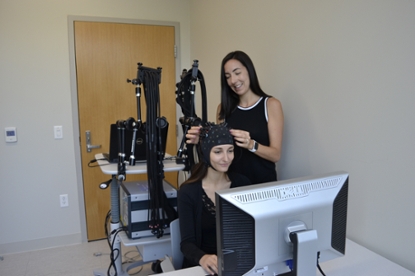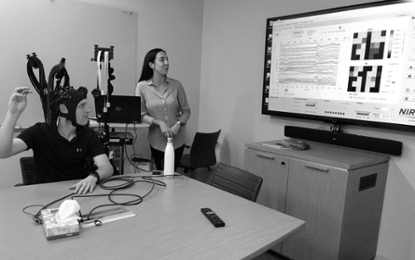What is fNIRS?
fNIRS stands for Functional Near-InfraRed Spectroscopy
Increased activity in the brain will cause increased blood flow to a particular brain region. When blood is flowing to an active brain region, it carries oxygen molecules with it. fNIRS measures these changes in oxygenated blood, and can tell us if or when a brain region is active during a particular task. It’s called “near-infrared” because oxygenated blood is red or near-infrared in colour.
To measure the changes in blood flow in the brain, fNIRS uses light sensors to detect oxygenated blood. With fNIRS, we use an array of light sensors called “sources” and “detectors”. Sources send light into the brain, and detectors detect the light signal sent from a source to measure changes in blood flow. The amount of light that goes into the brain with fNIRS is about the same as the amount of light that goes into the brain when walking outside on a sunny day.
When you first arrive at the lab, we'll tell you all about the experiment and what activities you will be doing. You can ask us questions about what we'll be doing and can decide if you would prefer not to participate.
Then we will measure the size of your head, and fit you with an fNIRS cap. The fNIRS cap will have an array of sources and detectors on it to measure your brain activity. The cap fits snugly, so that we can get a good measurement, but is comfortable to wear. But if you are worried or have questions, you can tell us right away. You can stop the experiment at any time.
The experimenter will plug the fNIRS cap into a computer to begin measuring your brain activity while doing an experimental task. The set-up for an fNIRS study is very quick – it usually only takes less than a minute to get the fNIRS cap on and begin collecting data.

Dr. Noonan sets up the fNIRS system on Western Graduate student Leah Brainin's head
fNIRS is similar to fMRI in what it measures, but is quite different in how we measure it. Unlike fMRI, the fNIRS machine does not make any noise. And, you don’t need to lie still during an fNIRS experiment. The following website can give you a more detailed explanation of fNIRS: https://en.wikipedia.org/wiki/Functional_near-infrared_spectroscopy

A participant completes a task while undergoing fNIRS brain imaging
The fNIRs system is located at the Western Interdisciplinary Research Building on the campus of the University of Western Ontario.

The Western Interdisciplinary Research Building
During some scans, you will be looking at and/or hearing stimuli and making responses using the response pad in your hand. During other scans, you can relax and watch a movie or close your eyes. Usually the experiments take about 30-60 minutes. After you're done, we can tell you what the experiment was about and show you what your brain activity looked like.
How should you prepare for an fNIRS session?
For your comfort and safety, participants in fNIRS studies should follow these guidelines:
-Participants' hair should be dry, and should not contain products such as hair gel. These products can distort the signals coming from the brain.
-Participants should not drink excessive amounts of liquid before coming to the scanner, especially those containing caffeine. That way you will not need to stop the session early to use the washroom.
-Try to be well rested for your study appointment, so that you can be at your best on study day.
-You can eat and drink normally on the day of your study.

